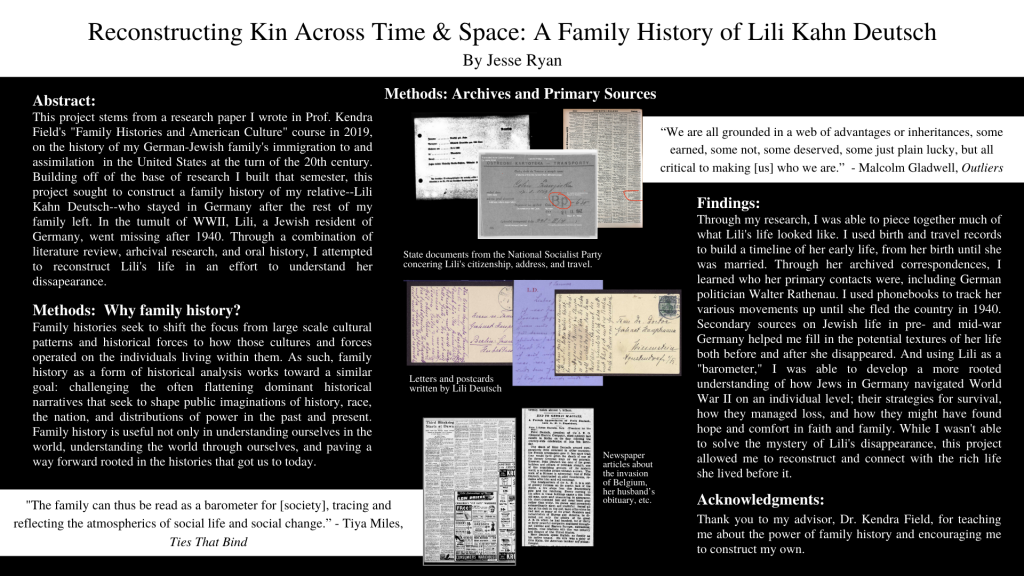Reconstructing Kin Across Time and Space: A Family History of Lili Kahn Deutsch
by Jesse Ryan
Mentor: Kendra Field, History; Funding source: Kokulis Fund

In his book Outliers, Malcom Gladwell writes that “we are all grounded in a web of advantages or inheritances, some earned, some not, some deserved, some just plain lucky, but all critical to making [us] who we are.” I first read Outliers in Kendra Field’s “Family Histories and American Culture” course last year, as an example of the methodology of family history and the kinds of stories it can yield. At the time, I was in the early stages of beginning my own family histories research on my great-great-grandfather Otto Kahn. Otto was a German-Jewish immigrant to New York City, raising a family at the turn of the 20th century. While I was interested in using family history tools to better understand larger patters of immigration, class, and Jewish-American assimilation through studying the New York Kahn family, I hadn’t previously thought about that project as also informing my own life and understanding of myself in the world. Gladwell’s assertion, though, that we are all, situated in a web of our families’ stories, advantages, and inheritances, struck me. I wanted to learn more about the Kahn family web than just the relatives who came to the U.S. I found myself asking, as Otto Kahn and his children pursued wealth, power, and whiteness in the United States, what were his Jewish siblings experiencing back in Germany? As the only Kahn sibling who was in Germany during the war, I chose to focus on Lili Deutsch Kahn. I wanted to know what her life was like, how she experienced the war, and how she and her brother Otto negotiated their diverging lives and subjectivities across continents.
My initial project about Otto Kahn in Professor Field’s class served as the foundation for my summer research. I used many of the same historical methods—oral history, literature review, and archival analysis—to construct what was essentially a storyboard for Lili Kahn’s life from beginning to end. Once I had a clear outline of her basic movements, contacts, and major life events, I turned to other family histories written about the Holocaust to give Lili’s story more texture. This was perhaps one of the most rewarding parts of the project—finding a community of Jewish genealogists and family historians working from similar questions and wrestling with similar themes. The summer culminated in my attending the International Association of Jewish Genealogical Societies 2020 Conference in August. There, I got to share Lili’s story and learn from historians experienced in the field of World War II family histories. While the Summer Scholars project I had envisioned pre-COVID, which included traveling to the Kahn’s hometown in Germany, obviously did not come to fruition, continuing to invest in this family research project led me not only to a better understanding of another branch of my family tree and a community of seasoned, like-minded scholars, but also one strand closer in weaving the Kahn family web, so “critical to making me who I am.”
I’d love to know what was more difficult to find than you thought it would be, and what information was readily available that you didn’t really expect. Tracing these histories seems like an overwhelming and difficult task, so you’ve done something really phenomenal here!